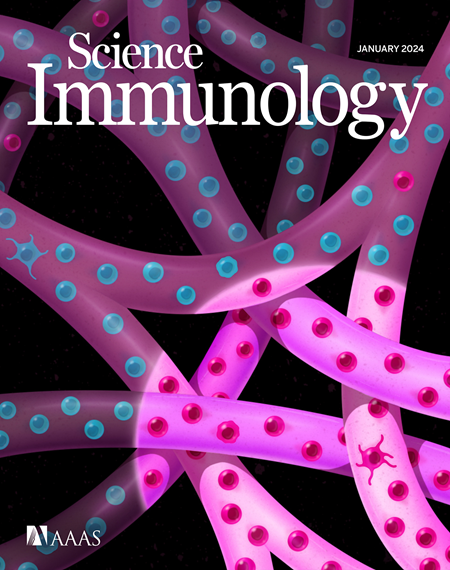C1q 使流感血凝素干结合抗体能够阻止病毒附着,并扩大了抗体逃逸的范围。
IF 17.6
1区 医学
Q1 IMMUNOLOGY
引用次数: 0
摘要
抗原漂移是流感病毒血凝素(HA)受体蛋白中氨基酸替代的逐渐积累,它使病毒能够逃避免疫。抗漂移的 HA 茎部特异性抗体(Abs)是一种很有前景的通用流感疫苗靶标。尽管人们认为抗干抗体不会阻断病毒附着,但我们在此发现,补体成分 1q(C1q)是一种具有六个抗体 Fc 结合域的 460 千道尔顿蛋白,它能抑制抗干抗体的附着,并增强其融合和神经氨酸酶抑制作用。因此,体外病毒中和活性可提高 30 倍,小鼠体内免受 PR8 流感感染的保护能力也得到增强。这些效果反映的是立体阻碍的增加,而不是抗体亲和力的提高。C1q 大大扩展了抗干体抗体病毒逃逸库,使其包括整个 HA 的残基,其中一些残基会导致球状区的抗原性改变或调节 HA 受体的嗜性。我们还发现,C1q 能增强非受体结合域抗 SARS-CoV-2 尖峰抗体的中和活性,这种效应取决于病毒表面的尖峰密度。这些研究结果表明,C1q 可以大大扩展抗体的功能,从而促进病毒进化和免疫逃逸。本文章由计算机程序翻译,如有差异,请以英文原文为准。
C1q enables influenza hemagglutinin stem binding antibodies to block viral attachment and broadens the antibody escape repertoire
Antigenic drift, the gradual accumulation of amino acid substitutions in the influenza virus hemagglutinin (HA) receptor protein, enables viral immune evasion. Antibodies (Abs) specific for the drift-resistant HA stem region are a promising universal influenza vaccine target. Although anti-stem Abs are not believed to block viral attachment, here we show that complement component 1q (C1q), a 460-kilodalton protein with six Ab Fc-binding domains, confers attachment inhibition to anti-stem Abs and enhances their fusion and neuraminidase inhibition. As a result, virus neutralization activity in vitro is boosted up to 30-fold, and in vivo protection from influenza PR8 infection in mice is enhanced. These effects reflect increased steric hindrance and not increased Ab avidity. C1q greatly expands the anti-stem Ab viral escape repertoire to include residues throughout the HA, some of which cause antigenic alterations in the globular region or modulate HA receptor avidity. We also show that C1q enhances the neutralization activity of non–receptor binding domain anti–SARS-CoV-2 spike Abs, an effect dependent on spike density on the virion surface. These findings demonstrate that C1q can greatly expand Ab function and thereby contribute to viral evolution and immune escape.
求助全文
通过发布文献求助,成功后即可免费获取论文全文。
去求助
来源期刊

Science Immunology
Immunology and Microbiology-Immunology
CiteScore
32.90
自引率
2.00%
发文量
183
期刊介绍:
Science Immunology is a peer-reviewed journal that publishes original research articles in the field of immunology. The journal encourages the submission of research findings from all areas of immunology, including studies on innate and adaptive immunity, immune cell development and differentiation, immunogenomics, systems immunology, structural immunology, antigen presentation, immunometabolism, and mucosal immunology. Additionally, the journal covers research on immune contributions to health and disease, such as host defense, inflammation, cancer immunology, autoimmunity, allergy, transplantation, and immunodeficiency. Science Immunology maintains the same high-quality standard as other journals in the Science family and aims to facilitate understanding of the immune system by showcasing innovative advances in immunology research from all organisms and model systems, including humans.
 求助内容:
求助内容: 应助结果提醒方式:
应助结果提醒方式:


